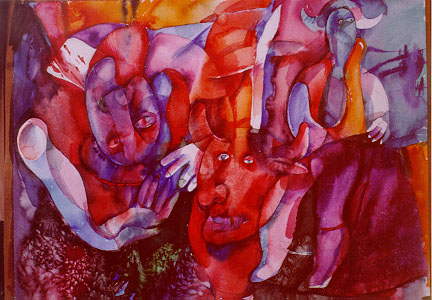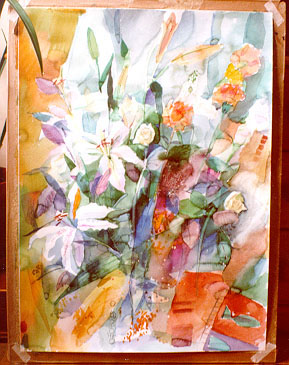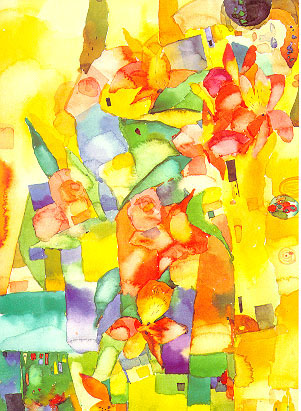PAINTER, PRINTMAKER
At the age of 24, Marianna Magurudova has already far more experience
of the world, and of painting, than most of her contemporaries in the second
year of the Fine Arts course at Brighton University. Feminine, willowy,
with a beguiling Russian accent, she has nevetheless a steely determination
to succeed. In this respect she is probably typical of modern Russia -
individualistic, self sufficient, go-getting.
Early days.
Marianna was born in Kislovodsk, in Southern Russia, in 1974. Both her parents are artists; her father is a successful oil painter, her mother an interior designer, so that the artistic vocation she felt from the very beginning ran in her veins. As soon as she could hold pens and pencils she practised with them, and at the age of 11 she used to go to a specialist art school in the afternoons. "I did not even ask myself what I wanted to do," she remembers." it was obvious I would not do anything else." When I asked her if there was any political indoctrination in her earliest childhood, before the fall of communism, she says she had to read Marx and Engels at the age of ten, but then, with the advent of Gorbachev, society opened up. In any case she was only really interested in her work.
Marianna went on to take a degree at Russias leading institute, the St Petersburg Academy of Fine and Applied Art. The training here was rigorous, and students had to study eight subjects, but the principal emphasis was on drawing, which shows in the quality of her work. The Academy had its own celebrated museum, and every year an exhibition of the best twenty of 1,200 competing students would be held. In 1992 she contributed no less than three works to the show. Eventually she was named top student.
Why did she come to Brighton?
Love! He was an Englishman named Mark, travelling in Russia in the summer
of 1994- "We met in the Hermitage Museum in St. Petersburg," she says.
"I went there with a friend to see an exhibition and while we were in the
cafe Mark came up to our table and asked if the seat was free. We ended
up talking for about two hours and exchanged addresses. After that we wrote
to each other and he started to call and came to see me again. He tried
to get a job but it was very hard so we decided to go to England."
Until now she had only the vaguest preconceptions about this
country, which in any case had been virtually inaccessible in the earlier
Soviet regime." So when I knew I was coming it was a bit like a dream."
Marianna arrived just before Christmas in 1994 and married Mark soon
after. They live now in one of the pretty streets up by the race course,
in a house where she also has a studio and exhibits her work during the
summer festival. It was then that I met her.
Work in Brighton.
Marianna has been here for just over two years now and it is a measure
of her talent and determination that she has already made considerable
inroads on the local scene, in spite of the fact that she is foreign
and so young. At the very beginning she found it impossible to obtain any
but the most menial employment, and she channelled all her creative energies
into her work.
I do everything I can to be accomplished, she says, the only
way you can get better is by working. This is born out by the fact that
she works at least eight hours a day, and is usually involved with three
canvases at a time. Any visitor to her home will find work constantly in
progress.
Within a year of her arrival Marianna was one of a a few select
artists who, from out of thousands of entrants, had work accepted in the
Sunday Times / Singer Friedlaender Watercolour Exhibition. Unusually, the
piece was her first ever abstract. By the following year she had won other
major national prizes, including the Winsor & Newton Young Artist Award,
and her work had been shown at the prestigious Mall Gallery. Her work is
regularly to be seen on the walls of the Gallery, in Rottingdean, and in
february 1998 she had her own show at the Barbican, in London.
Yet in spite of such early success she is still a student, with another
year to go at Brighton University. Her studies are entirely self-financed
, but she has great respect for the course. When she graduates from there,
she hopes to go on to the Royal College of Art, in London.
At this stage, Mariannas art is in a constant state of evolution, but
inevitably it has very different roots from her peers on the course.
Her earliest work here was decidedly Russian in feel, with its references
to peasant myths, to folk forms like the lubok, to the icons of Andrei
Rublev and reminiscent, to the western eye, of the naive painting of Marc
Chagall. But she is still in the process of finding herself -I want to
know everything, she says, and inevitably since her arrival she has been
exposed to a whole new range of influences. She finds British art impressive,
had never seen anything like the Turner Prize, Found the Sensation Exhibition
at the RoyAl Academy, which caused such controversy at the end of 1997,
shocking, but ultimately unimpressive. Now, perhaps influenced by continental
painters like Paladino, her painting is becoming increasingly abstract.Yet
when I ask her in what direction she is moving she says she doesnt know,
although she can sense it within her and responds to her inner inspiration.
...And living in Brighton?
I like Brighton very much. London is very beautiful but it does
not feel like home; Brighton does. Everyone is very friendly here and I
have never felt like a foreigner.
Marianna does seem quite at home in her mid-terrace house, surrounded
by her work. She says it is cosy, like her home town of Kislovodsk, and
people are very friendly, although she cannot understand why young people
drink so much. Like everyone else she likes the proximity to London; the
sea and the beautiful countryside, which is so green and orderly. She finds
the small houses and streets sympathetic, but when I ask her what building
she most dislikes, she replies, astonishingly, the Royal Pavilion! Paradoxically
the area that most appeals to her is the old open market, with its bright
colours and, to her, exotic products.
I love going around Brighton market looking at all the different fresh
vegetables, she says. Some of them, like ugli fruit, I have not seen before.
From the foothills of the Caucasus to the Open Market of Brighton is
a long journey to have made at the age of twenty-four. For this determined
young Russian artist one feels the future will be both rich and rewarding.
I love painting, she says. Its great when you enjoy doing something,
and when other people like it as well its a great compliment.
this painting was the Georgian women Marianna
used to observe near her hometown in
southern Russia, preparing food and singing as
they worked. She was not sure how to fill in
the foreground and so she decided to
insert the lemons. She remembers that
during her earliest days in Brighton some
friends sent her some lemons from Georgia,
and when she opened the box the
perfume filled the room.


Fruit and flowers, 1996. This bright watercolour
shows her love of the subject matter that draws her to
Brighton Market. In spite of its apparent
effortlessness it also shows the underlying strength of her
draughtmanship. It was on display,
and sold, at her studio during the Brighton Festival
